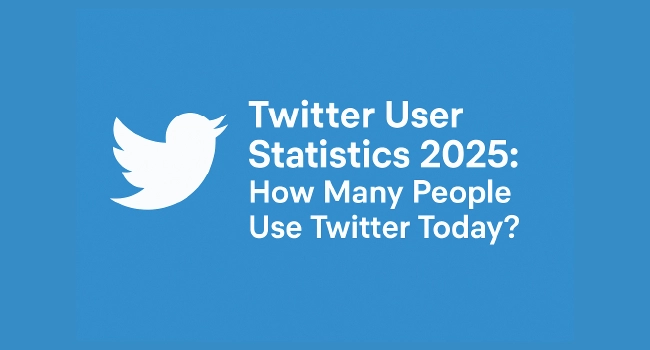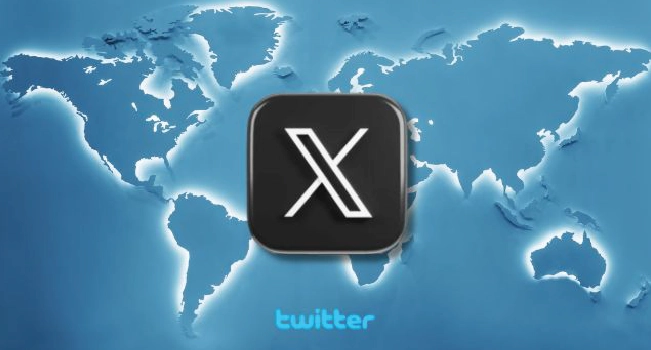Understanding Twitter user statistics helps us see the bigger picture of how the platform is used today. Every number tells a story, from how many people log in, which countries lead the way, all the way to what kind of activity drives conversations.

If you’ve ever wondered why certain tweets trend so fast or why some regions dominate discussions, the answers are often hidden in these stats.
In this article, we’ll break everything down in simple terms, giving you clear insights you can actually use to make sense of Twitter’s global audience.
Understanding What “Twitter Users” Really Means
Before diving deeper into Twitter user statistics, we should clear up what “users” really means. Different reports count people in different ways, and that’s where the confusion usually starts. Here’s a simple breakdown:
-
Monthly Active Users (MAU): The old way of counting anyone who logged in at least once a month.
-
Monetizable Daily Active Users (mDAU): Twitter’s last official, audited number before going private. It tracked daily users who could be shown ads.
-
Advertising Audience (Ad Reach): The current number marketers see in Twitter’s ad tools. This is the best global snapshot we can use today.
-
Average Monthly Active Recipients (AMAR): A figure Twitter must publish in Europe under the Digital Services Act. It shows active users in each EU country.
-
Owner Claims: Elon Musk has mentioned figures like 540M or 600M, but these are not independently verified.
For this article, we’ll mainly refer to the Advertising Audience (Ad Reach) numbers because they are updated regularly and cover the global picture. When needed, we’ll also highlight the EU AMAR reports for regional accuracy and the last official mDAU for historical context.
Global Twitter User Statistics

When we look at the latest Twitter user statistics the platform’s advertising audience reaches about 586.8 million people worldwide.
That equals more than 10% of all internet users and roughly 12% of adults aged 18 and older. These numbers give us the clearest global snapshot today, since they come directly from Twitter’s advertising system and are updated monthly.
A few things stand out on the global level:
-
Gender split: About 67% are men and 33% are women, showing a clear imbalance.
-
Age groups: The largest segment is 25–34 years old, followed by 18–24, which highlights the strong pull among younger adults.
-
Global rank: While smaller than platforms like Facebook or Instagram, Twitter remains one of the most powerful for real-time conversation and breaking news.
-
Language diversity: The platform supports over 40 languages, but most activity comes from English, Japanese, Spanish, and Arabic communities.
-
Event-driven use: Big spikes happen during global events such as elections, World Cup matches, or breaking news, making Twitter the go-to “second screen.”
-
Advertising potential: With almost 600M reachable users, advertisers can tap into niche audiences worldwide, targeting by interest as well as demographics.
Top 10 Countries by Twitter Users
The global picture is useful, but the real story comes into focus when we look at where Twitter is most popular. According to the most recent Twitter user statistics, the United States and Japan dominate, but fast-growing regions like India, Indonesia, and Brazil also play a huge role. Here’s a clear breakdown of the top 10 countries by ad audience and their share of the global total:
| Country | Estimated Users (Ad Reach) | Share of Global Audience |
|---|---|---|
| United States | ~106 million | 19.7% |
| Japan | ~67 million | 11.4% |
| India | ~31.8 million | 5.4% |
| United Kingdom | ~28.9 million | 4.9% |
| Indonesia | ~27.5 million | 4.7% |
| Brazil | ~24.4 million | 4.2% |
| Saudi Arabia | ~23.6 million | 4.0% |
| Mexico | ~22.3 million | 3.8% |
| Türkiye | ~20.3 million | 3.5% |
| Thailand | ~18.8 million | 3.2% |
A closer look at these numbers tells us a lot about Twitter’s role in different regions:
-
U.S. vs. Japan: The U.S. drives Twitter's global reach, but Japan has one of the highest engagement rates per user. Japanese users post more frequently, making the country a cultural driver on the platform despite a smaller population.
-
India and Indonesia: These two markets highlight Twitter's growth in mobile-first economies. As internet access expands, Twitter becomes a key space for political debate, local trends, and celebrity engagement.
-
Saudi Arabia: With more than 20M reachable users, Saudi Arabia has one of the world's highest per-capita adoption rates. Twitter is central to public conversation, from sports to government announcements.
-
Latin America (Brazil & Mexico): These countries use Twitter heavily around sports and entertainment. For example, World Cup matches create some of the platform's largest global traffic spikes.
Twitter Users by Continent

Now that we’ve looked at the biggest countries, it’s time to zoom out and see how Twitter performs across entire continents. This view helps us understand not just where the numbers are, but how usage patterns differ depending on culture, language, and access to the internet.
Europe
Europe's figures come from the EU's official AMAR reporting. Between October 2024 and March 2025, France led with around 17.4M users, followed by Germany (15.6M) and Spain (15.1M). These counts are lower than the previous reporting period, showing a slight decline. Still, Twitter remains a key space for politics, news, and real-time commentary across the region.
North America
The U.S. is Twitter's largest market with about 106M users, making up nearly a fifth of the global audience.
Beyond size, U.S. users are central in shaping global trends and hashtags. Canada, with a smaller but engaged audience, leans heavily on Twitter for political discussions, sports, and breaking news updates.
Asia-Pacific
Japan sits in second place globally with 67M users, but what's more striking is its engagement rate, Japanese users post more often than almost anyone else.
India and Indonesia follow, with 31.8M and 27.5M users. In these mobile-first countries, Twitter is often the go-to space for political debate and celebrity culture.
Latin America
Brazil (24.4M) and Mexico (22.3M) dominate here. Both countries are known for using Twitter during live events, especially football matches, which generate some of the highest spikes in global activity.
Argentina and Colombia add to the region's strong footprint, making Latin America a hub for sports and entertainment chatter.
Middle East & North Africa (MENA) + Turkiye
Saudi Arabia is the standout in this region, with 23.6M users and one of the world's highest adoption rates compared to population size. Twitter is deeply woven into daily life there, often used for official announcements and community debates.
Turkiye adds another 20.3M, making it a major bridge between European and Middle Eastern audiences.
Sub-Saharan Africa
Twitter's footprint in Sub-Saharan Africa is smaller than in other regions but shows consistent growth. Nigeria leads with an estimated 5–6M users, making it the largest market in the region. South Africa follows with about 4M, reflecting strong adoption tied to its higher internet penetration.
Kenya and Ghana add a few million more combined, and while the totals are lower, Twitter here has one of the highest ratios of mobile-only users and growth is expected to continue.
Oceania
In Oceania, Twitter reaches around 4.7M people in Australia and just over 1M in New Zealand. Together, that's more than 5.5M users, representing a significant share of the region's online population.
Australia accounts for the vast majority of the audience, giving it one of the highest per-capita penetration rates outside of North America and Europe. Although the absolute numbers are small compared to Asia or the U.S., Oceania's adoption shows that Twitter remains a central platform even in smaller digital markets.
Traffic & Engagement Signals

Looking at Twitter user statistics is only part of the picture, you also need to know how people interact once they’re on the platform. In July 2025, X drew around 4.5 billion visits, with each session lasting nearly 13 minutes. That’s a lot of time spent reading, posting, and engaging.
Here are a few takeaways:
-
Who’s visiting: About 67% are men, and 33% are women .
-
Age split: The largest group is 25–34 years old, followed by 18–24, showing strong traction among younger adults.
-
Frequency: Many users open the app multiple times daily, keeping Twitter central to their digital routine.
Now here’s where things get practical. Twitter’s algorithm rewards speed. Posts that pick up retweets and likes quickly are far more likely to be pushed into trending feeds. If your tweet gains traction in the first few minutes, it can snowball into thousands of views. But if it stalls, even great content can disappear.
That’s why giving your content a jump-start matters. With Buy Twitter Retweets, you can secure that early burst of engagement, making it much easier for your posts to gain visibility. It’s like giving your tweet the momentum it needs to break through the noise and reach the audience you deserve.
Traffic & Engagement Signals
Looking at Twitter user statistics is useful, but it doesn’t tell the full story. To really understand the platform, you need to see how people interact with it day to day.
In July 2025, x.com recorded about 4.5 billion visits, with each visit lasting on average 12 minutes and 50 seconds according to Similarweb. A few engagement facts stand out:
-
Mobile first: Over 80% of users access Twitter from a mobile device. This shows that Twitter is truly a platform for on-the-go engagement, where short bursts of attention create massive waves of interaction.
-
Daily habit: Roughly 55% of Twitter’s audience opens the app daily, and many check it multiple times per day . This makes Twitter one of the stickiest platforms, with users forming routines around logging in.
-
Event spikes: Traffic isn’t steady. During events like the FIFA World Cup, U.S. elections, or sudden celebrity news, Twitter activity can double or triple within hours. In fact, during the 2022 World Cup semifinal, Twitter reported over 2 million tweets per minute at peak moments (Twitter company reports, archived before going private).
Why does this matter for you? Because Twitter’s algorithm is designed to notice early momentum. Tweets that collect retweets and likes within the first few minutes are far more likely to be recommended to others. A post that doesn’t catch fire quickly may disappear under the flood of content, even if it’s brilliant.
That’s exactly why we created our buy Twitter retweets service. All retweets come from authentic accounts, and we focus on fast delivery so your content gains traction right when it matters most. This early boost makes it easier for your tweets to break through the noise and reach the wider audience you deserve.
Conclusion
Exploring the latest Twitter user statistics shows us how varied and dynamic the platform’s audience really is.
With a global ad reach of nearly 586 million people, Twitter continues to play a vital role in real-time communication. The U.S. and Japan together account for almost one-third of all users, while fast-growing regions like India, Indonesia, Brazil, and Saudi Arabia highlight where the platform’s future lies.
In Europe, official AMAR reports reveal a slight decline compared to earlier periods, showing how adoption can shift under regulatory pressure. Meanwhile, Sub-Saharan Africa and Oceania, though smaller in size, demonstrate steady growth and strong per-capita engagement.
FAQs | Frequently Asked Questions |
Which country has the largest Twitter audience?
The United States has the largest user base with around 106 million people, accounting for nearly 20% of all Twitter users worldwide.
How many users are reported in Europe under the DSA?
According to the latest AMAR reports (October 2024 – March 2025), Europe has around 95 million active recipients. France, Germany, and Spain lead the region in adoption.
What is the gender split on Twitter?
Globally, the audience skews male: about 67% men and 33% women. This makes Twitter one of the most male-dominated major social platforms.
How many daily active users does Twitter have now?
The last official figure for monetizable daily active users (mDAU) was 237.8 million in Q2 2022, before the company went private. Since then, ad reach and owner claims have replaced audited daily active counts.
Can I look at Twitter statistics from past years?
Yes. Tools and reports allow you to search Twitter by year and see how user numbers, demographics, and traffic trends have changed over time. This helps identify growth patterns and market shifts across regions.
